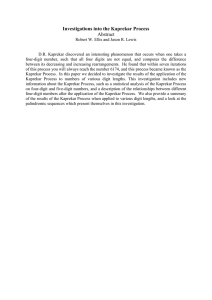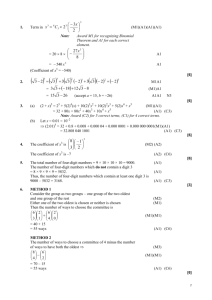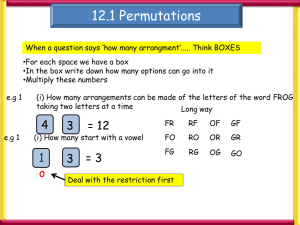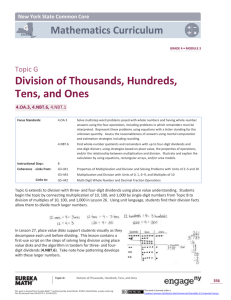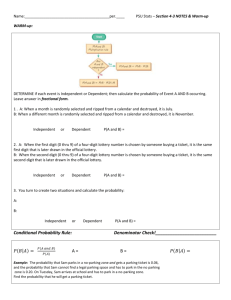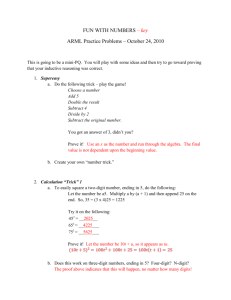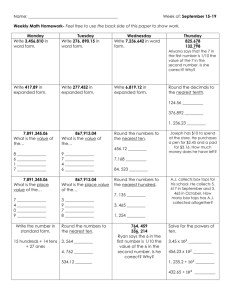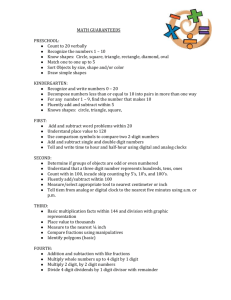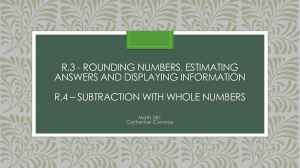Year 2 Teaching Sequence xxx
advertisement
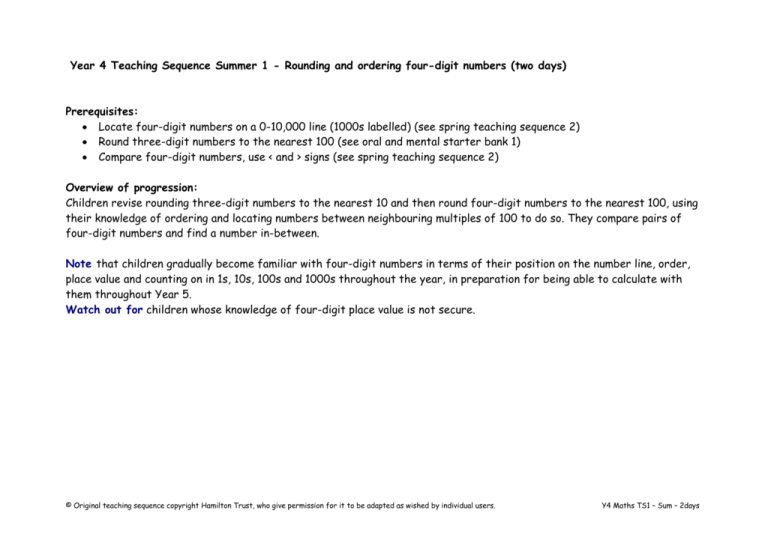
Year 4 Teaching Sequence Summer 1 - Rounding and ordering four-digit numbers (two days) Prerequisites: Locate four-digit numbers on a 0-10,000 line (1000s labelled) (see spring teaching sequence 2) Round three-digit numbers to the nearest 100 (see oral and mental starter bank 1) Compare four-digit numbers, use < and > signs (see spring teaching sequence 2) Overview of progression: Children revise rounding three-digit numbers to the nearest 10 and then round four-digit numbers to the nearest 100, using their knowledge of ordering and locating numbers between neighbouring multiples of 100 to do so. They compare pairs of four-digit numbers and find a number in-between. Note that children gradually become familiar with four-digit numbers in terms of their position on the number line, order, place value and counting on in 1s, 10s, 100s and 1000s throughout the year, in preparation for being able to calculate with them throughout Year 5. Watch out for children whose knowledge of four-digit place value is not secure. © Original teaching sequence copyright Hamilton Trust, who give permission for it to be adapted as wished by individual users. Y4 Maths TS1 – Sum – 2days Objectives: Compare and order four-digit numbers and find a number in-between Round three-digit numbers to the nearest 10 and four-digit numbers to the nearest 100 Whole class Group activities Paired/indiv practice Resources Ask chn to draw a line from 300 to 400 on their whiteboards and to place 348 on it. How did you work out where to place it? Discuss how it is just before 350 which is in the middle. What multiple of 10 is before 348? And after? Now draw a line from 340 to 350 and place 348 on it. Take feedback about how chn decided where to place 348, drawing out that it is nearer to 350 than 340. 348 rounds to 350 when we round it to the nearest 10. Think of a number that rounds to 340 and place it on your line. Share chn’s boards. Sketch a line from 250 to 270, marking on 260. Think of two numbers between 250 and 260, one which rounds to 250 and one which rounds to 260 and place them on your line. Now think of two numbers between 260 and 270, one which rounds to 260 and one which rounds to 270. Share chn’s boards. Ask one child to stand at one side of the classroom holding a mini-whiteboard with 4600 written on it, and another to stand at the other side of the room with 4700. Ask another child to stand where they think 4654 might be on an imaginary number line between these two points, keeping the number secret. Ask children to discuss in pairs what number you have given the child, and to write an estimate on their whiteboards. Tell children that they can choose two multiples of ten for you to put on the line. When they have reached an agreement (e.g. 4650 and 4660) write the numbers on Group of 4-5 children Write the following additions on the board: 5567 + 3112, 5689 + 3429, 5325 + 3479, 5899 + 3327. Which of these do you think will have the smallest total? Talk to your partner. Take feedback. Discuss how it is not that easy, but that they can use their rounding skills to help. Ask children to round each number to the nearest 100, and we write the additions: 5600 + 3100, 5700 + 3400, 5300 + 3500, 5900 + 3300. Is it any easier now? Work with a partner to write the four additions in order from the smallest total to the largest total. Afterwards give children calculators to find the exact totals and check their ordering. Easier: Use calculations 5311 + 3511, 5389 + 3599, 5278 + 3511, 5235 + 3523. Children work in pairs to shuffle a pack of 0-9 digit cards, and take four to make a four-digit number. They discuss which two multiples of hundred it lies between, sketch a line between the two multiples of 100 and mark on the number they made. They ring the nearest multiple of 100. Easier: Children have a 30004000 landmarked line (100s labelled), mark on 3050, 3150, 3250… 3950. They then make at least six numbers between 3000 and 4000 and mark them on the line in different coloured pencils. They ring the nearest multiple of 100 in the same colour pencil as the marked number. 0-9 digit cards 3000-4000 landmarked line, 100s labelled (see resources) Coloured pencils © Original teaching sequence copyright Hamilton Trust, who give permission for it to be adapted as wished by individual users. Y4 Maths TS1 – Sum – 2days whiteboards and ask two children to stand there. The mystery number child might need to move a little. Do you want to change your estimate? Reveal the mystery number. Talk to the child about how he/she knew where to stand. Is 4654 nearer to 4600 or to 4700? Repeat, asking a child to stand where they think 4625 might be. Repeat, but this time with 5000 at one end of the human number line and 6000 at the other, asking a child to stand where 5579 might be. After a while say that they can choose two multiples of 100 to place on the line (e.g. 5500 and 5600). Ask children to write their estimates on their boards. Could the number be 5525? Why not? Draw out that the number is closer to 5600 than to 5500. Reveal the answer. If you have a number which rounds to 5600 not 5500, you made a good estimate. Can you think of a number between 5500 and 5600 which will round to 5500? Write this on a whiteboard and ask a child to stand in approximately the right place. What would we round 5550 to? Explain that we would round 5550 up to 5600. Call out four-digit numbers and ask children which multiple of 100 they are closer to. They write the correct multiple of 100 on their whiteboards. Now show me a number closer to 4500 than 4600. Shuffle a pack of 0-9 digit cards, take four cards and show them to the children. What’s the biggest four-digit number we can make with these four digits? Write it on your whiteboard. Ask a child to help locate this number on a 0-10,000 landmarked line (see resources). What’s the smallest number we can make with these digits? If one card is a Group of 4-5 children Split the group into two small teams. Show the grid of four-digit numbers (see resources). Explain that one team will try to get from top to bottom, and one team will try and get from left to right. They do this by making a chain of Children work in pairs to shuffle a pack of 1-9 digit cards, take four cards and make the biggest number they can, the smallest, and one number in-between. They write the three numbers in order. Easier: Children work in pairs to © Original teaching sequence copyright Hamilton Trust, who give permission for it to be adapted as wished by individual users. 0-9 digit cards 0-10,000 landmarked line (see resources) Hexagon grid Y4 Maths TS1 – Sum – 2days zero, explain that they can’t put this first, as the number would really be a three-digit number. Ask a child to help locate this number on a 0-10,000 landmarked line. Now think of a number in-between these two, using the same four digits. Take feedback and mark all the numbers on the landmarked line to confirm that they are in between the two original numbers. Repeat, choosing four digits, and making the smallest and greatest possible numbers, and then numbers inbetween. Which is the most important digit when comparing two four-digit numbers? What if the hundreds digit is the same? four-digit numbers so that the next number is greater than the previous number. So for example if they choose 3567, they cannot chose 3362 next. If the number they choose is bigger than the previous one, they colour it in. But they cannot choose a hexagon already chosen by the other team! Harder: Children play in pairs. shuffle a pack of 0-9 digit cards, take eight cards to make two four-digit numbers. They think of a number in-between, and write the three numbers in order from the smallest to the greatest. They mark the two numbers they make on a 0-10,000 landmarked line (see resources) before thinking of a number in-between. Harder: Children think of three numbers in-between and write the five numbers in order. © Original teaching sequence copyright Hamilton Trust, who give permission for it to be adapted as wished by individual users. (see resources) Sheet of 010,000 landmarked lines (see resources) Y4 Maths TS1 – Sum – 2days
